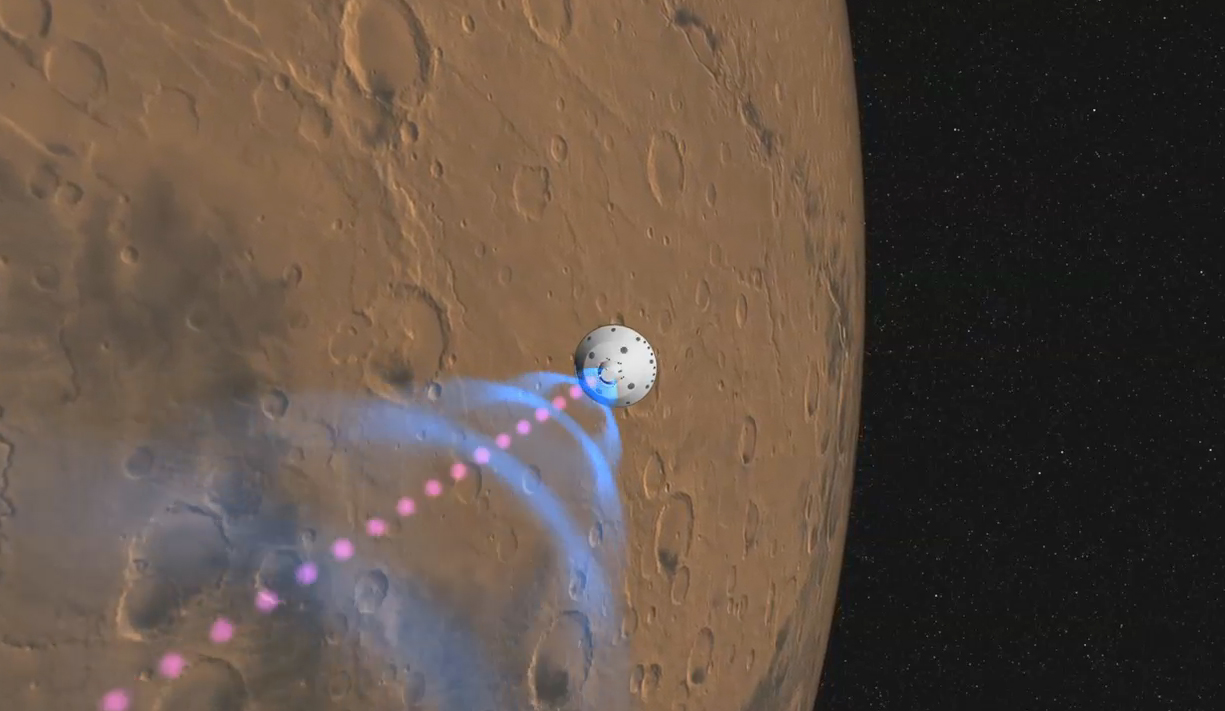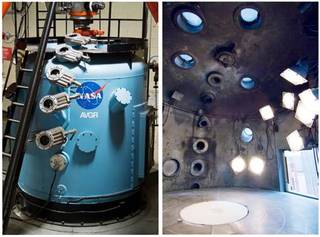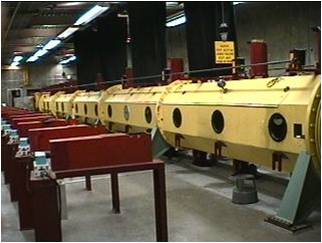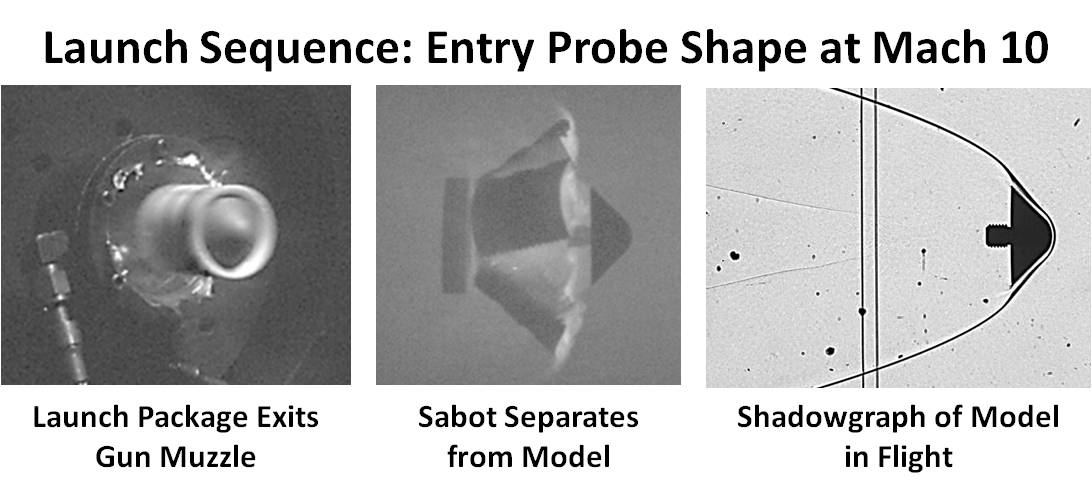NASA Ames Ballistic Ranges
Providing critical testing support to the Nation’s Research and Development activities in hypervelocity impact physics, aerodynamics, aerothermodynamics , flow-field structure and chemistry.
Benefit
The facilities provide the Nation with unique, critical and mission-enabling test capabilities, allowing small-scale simulations and low-cost “flight tests” in ground based facilities. The Range Complex has a comprehensive suite of highly adaptable, world-class, test hardware and a staff with extensive expertise garnered from a wide range of test experience. Together, they offer a unique set of testing possibilities for a wide variety of hypervelocity topics including: meteor or asteroid impacts on a planet or moon surface; micrometeoroid impacts on spacecraft while en route to mission specific destinations; the aerodynamics, aerothermodynamics and flow field characteristics of entry vehicles (for Earth entry and other planetary atmospheres) and other hypersonic vehicles.
Research Overview
The Ballistic Range Complex currently consists of three facilities: the Ames Vertical Gun Range (AVGR), the Hypervelocity Free Flight Aerodynamic Facility (HFFAF), and the Hypervelocity Free Flight Gun Development Facility (HFFGDF). Together, they enable a broad spectrum of research as outlined below.
The Ames Vertical Gun Range (AVGR) is a unique NASA facility that is used to simulate high-speed, celestial body impacts on a small scale. Data obtained from such studies can be used to establish a clearer understanding of the physics and phenomena associated with crater formation processes; impactor (projectile) failure modes and mechanisms; and, debris dispersion and characterization. In addition, this facility can be used to simulate micrometeoroid impact upon spacecraft traveling from earth to a mission specific destination and, thereby, examine vulnerability to critical damage.
The AVGR first began operations in 1966 in support of the Apollo program as a means to gain a better understanding of lunar surface geomorphology. Almost five decades later, this unique facility continues to provide invaluable data for NASA’s Planetary Geology and Geophysics program. During its long history, the AVGR has also supported NASA’s Exobiology and Solar System Origins programs, and provided critical enabling data for such missions as Cassini, Stardust, Mars Odyssey, Mars Exploration Rovers (MER), Deep Impact and Lunar Crater Observation and Sensing Satellite (LCROSS).
A family of model-launching guns (both powder and light-gas) is used to accelerate particles of various size (0.005 to 7.6 mm dia.), shape (spherical, cylindrical, irregular) and material composition (metallic, plastic, glass, mineral, etc.) to velocities approaching 7 km/sec. The angle of elevation of the gun with respect to the horizontal plane can be varied in 15° increments from 0° to 90°, thus permitting oblique angles of impact with respect to the gravitational vector.
A large impact chamber (14m3), which can accommodate sizable targets of varying composition (solid, aggregate, liquid, etc.), allows for testing at sub-atmospheric pressures (as low as 0.04 torr) and in gases other than air. Primary instrumentation consists of a diverse suite of state-of-the-art, high-speed imaging systems that can record the impact event and cratering processes in great detail. These systems can be operated over a wide range of framing rates (up to 1,000,000 fps), exposure times, resolution levels, aspect ratios (image sizes), and record lengths. In addition, spectroscopy, Particle Image Velocimetry (PIV), and other forms of instrumentation can be accommodated through special arrangement.
The Hypervelocity Free-Flight Facilities (HFFF) Complex consists of two active ballistic ranges: the Aerodynamic Facility (HFFAF) and the Gun Development Facility (HFFGDF). These are NASA’s only remaining aeroballistic ranges.
The HFFAF is the only aeroballistic range in the nation currently capable of performing aerodynamic studies in gases other than air and at sub-atmospheric pressures. It is used primarily to study the aerodynamics, aerothermodynamics and gas-dynamics associated with hypervelocity flight (as occurs during atmospheric entry). Data derived from observations of small-scale model flight include: aerodynamic parameters (i.e. lift, drag & pitching moment coefficients, dynamic stability criterion, etc.), flow-field characteristics (shock structures, spectral emission details of shock layers & wakes), model ablation behavior, and surface temperature distributions (heat transfer rates, transition locations).
The HFFGDF is a very useful compliment to the HFFFAF. It currently utilizes an atmospheric test section, which has virtually unobstructed, orthogonal views and allows for highly lifting/swerving models. This yields high-fidelity recordings of model trajectories. In an alternate configuration, the atmospheric test section can be replaced with a flight tube and impact chamber to enable light-gas gun development studies and hypervelocity impact testing.
The HFFF Complex began operations in 1964 in support of the Apollo program. Since then it has produced an extensive legacy of invaluable support for such missions and programs as: Planetary Atmospheric Entry Test (PAET), Viking, Pioneer Venus, Galileo, Aero-assist Flight Experiment (AOTV/AFE), National AeroSpace Plane (NASP), Space Station (ISS), Reusable Launch Vehicle (RLV/X-33), Mars Science Laboratory (MSL), Next Generation Launch Technologies (NGLT), In Space Propulsion (ISP), Shuttle Return to Flight (RTF), Crew Exploration Vehicle (CEV/Orion), Fundamental Aerodynamics Program (FAP), Low Density Supersonic Decelerator (LDSD/SIAD), and commercial access to space vehicles.
Both facilities within the HFFF Complex utilize a common arsenal of model-launching guns (7.1 to 38 mm light-gas guns, 20 to 61 mm powder guns) to accelerate small-scale models of various size, shape and material composition to velocities in excess of 8 km/sec.
The HFFAF test section is 75’ long, 39” in diameter, and is equipped with sixteen, orthogonal, shadowgraph-imaging stations spaced at 5’ intervals. The test section can be filled with a variety of gases (air, nitrogen, CO2, etc.) to pressures ranging from 0.03 to 760 torr, and at ambient temperature. A complete set of 32 shadowgraph images can be generated per test for aerodynamic studies. Alternatively, a suite of visible ICCD and IR cameras can be substituted at various stations to record the model surface temperature distribution at various points along its flight path. This technique is particularly useful for aerothermodynamic studies.
The HFFGDF has an ambient atmospheric test section that is 6.5’ x 6.5’ in cross section and 16’ in length. Eight (or more) ICCD cameras can be used to capture an orthogonal set of multiple exposure images to produce a high fidelity record of a model’s flight trajectory.
Background NASA Ames has a long tradition of leadership in the use of ballistic ranges for the study of the physics and phenomena associated with hypervelocity flight. The Range Complex has provided critical testing in support of many of NASA’s Space Transportation and Planetary Programs. This tradition of leadership in testing support for hypervelocity impact physics, aerodynamics, aerothermodynamics, flow-field structure and chemistry dates back to the NACA era of the 1950’s. Today, the Ballistic Range Complex continues to provide unique, mission-enabling support for the Nation’s programs in planetary geology and geophysics, exobiology, solar system origins, earth atmospheric entry, planetary entry & aerobraking vehicles, and various vehicle configurations for supersonic and hypersonic flight.
POC
Charles Cornelison
Mail Stop 204A-5
P.O. Box 1
Moffett Field, CA 94035-0001
Voice 650.604.3443
Fax 650.604.4201



























